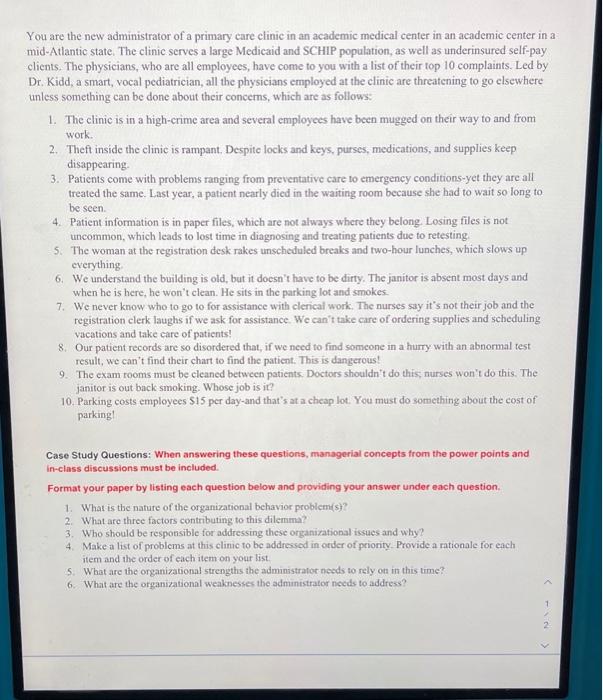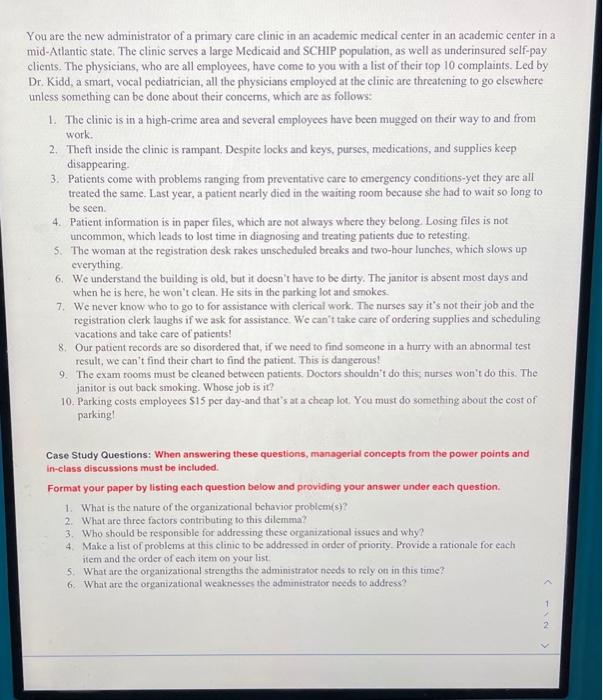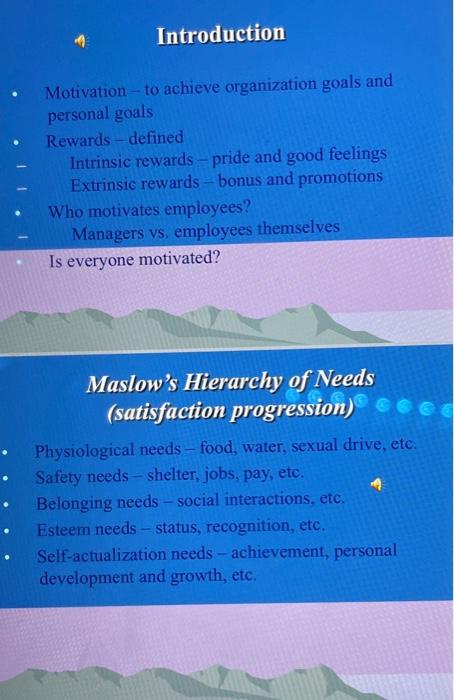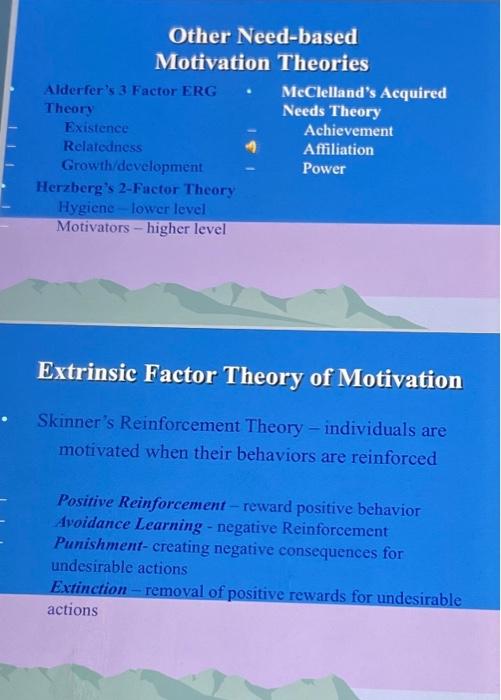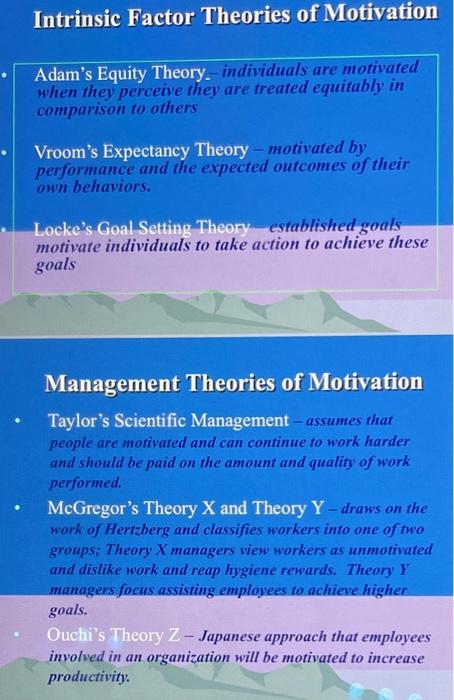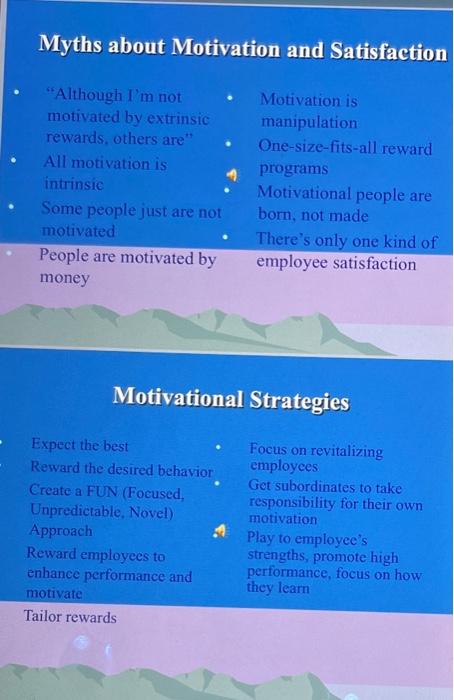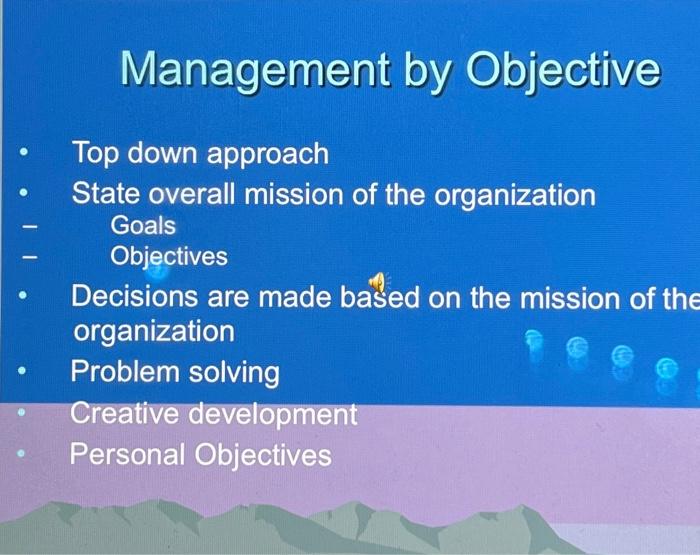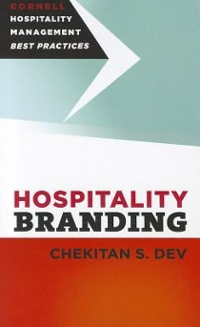You are the new administrator of a primary care clinic in an academic medical center in an academic center in a mid-Atlantic state. The clinic serves a large Medicaid and SCHIP population, as well as underinsured self-pay clients. The physicians, who are all employees, have come to you with a list of their top 10 complaints. Led by Dr. Kidd, a smart, vocal pediatrician, all the physicians employed at the clinic are threatening to go clsewhere unless something can be done about their concerns, which are as follows: 1. The clinic is in a high-crime area and several employees have been mugged on their way to and from work. 2. Theft inside the clinic is rampant. Despite locks and keys, purses, medications, and supplies keep disappearing. 3. Patients come with problems ranging from preventative care to emergency conditions-yet they are all treated the same. Last year, a patient nearly died in the waiting room because she had to wait so long to be seen. 4. Patient information is in paper files, which are not always where they belong. Losing files is not uncommon, which leads to lost time in diagnosing and treating patients due to retesting. 5. The woman at the registration desk rakes unscheduled breaks and two-hour lunches, which slows up everything. 6. We understand the building is old, but it doesn't have to be dirty. The janitor is absent most days and when he is here, he won't clean. He sits in the parking lot and smokes. 7. We never know who to go to for assistance with clerical work. The nurses say it's not their job and the registration clerk laughs if we ask for assistance. We can't take care of ordering supplies and scheduling vacations and take care of patients! 8. Our patient records are so disordered that, if we need to find someone in a hurry with an abnormal test result, we can't find their chart to find the patient. This is dangerous! 9. The exam rooms must be cleaned between patients. Doctors shouldn't do this, nurses won't do this. The janitor is out back smoking. Whose job is it? 10. Parking costs employees $15 per day-and that's at a cheap lot. You must do something about the cost of parking! Case Study Questions: When answering these questions, managerial concepts from the power points and in-class discussions must be included. Format your paper by listing each question below and providing your answer under each question. 1. What is the nature of the organizational behavior problem( s )? 2. What are three factors contributing to this dilemma? 3. Who should be responsible for addressing these organizational issues and why? 4. Make a list of problems at this clinie to be addressed in order of priority. Provide a rationale for each item and the order of each item on your list. 5. What are the organizational strengths the administrator needs to rely on in this time? 6. What are the organizational weaknesses the administrator needs to address? You are the new administrator of a primary care clinic in an academic medical center in an academic center in a mid-Atlantic state. The clinic serves a large Medicaid and SCHIP population, as well as underinsured self-pay clients. The physicians, who are all employees, have come to you with a list of their top 10 complaints. Led by Dr. Kidd, a smart, vocal pediatrician, all the physicians employed at the clinic are threatening to go clsewhere unless something can be done about their concerns, which are as follows: 1. The clinic is in a high-crime area and several employees have been mugged on their way to and from work. 2. Theft inside the clinic is rampant. Despite locks and keys, purses, medications, and supplies keep disappearing. 3. Patients come with problems ranging from preventative care to emergency conditions-yet they are all treated the same. Last year, a patient nearly died in the waiting room because she had to wait so long to be seen. 4. Patient information is in paper files, which are not always where they belong. Losing files is not uncommon, which leads to lost time in diagnosing and treating patients due to retesting. 5. The woman at the registration desk rakes unscheduled breaks and two-hour lunches, which slows up everything. 6. We understand the building is old, but it doesn't have to be dirty. The janitor is absent most days and when he is here, he won't clean. He sits in the parking lot and smokes. 7. We never know who to go to for assistance with clerical work. The nurses say it's not their job and the registration clerk laughs if we ask for assistance. We can't take care of ordering supplies and scheduling vacations and take care of patients! 8. Our patient records are so disordered that, if we need to find someone in a hurry with an abnormal test result, we can't find their chart to find the patient. This is dangerous! 9. The exam rooms must be cleaned between patients. Doctors shouldn't do this, nurses won't do this. The janitor is out back smoking. Whose job is it? 10. Parking costs employees $15 per day-and that's at a cheap lot. You must do something about the cost of parking! Case Study Questions: When answering these questions, managerial concepts from the power points and in-class discussions must be included. Format your paper by listing each question below and providing your answer under each question. 1. What is the nature of the organizational behavior problem( s )? 2. What are three factors contributing to this dilemma? 3. Who should be responsible for addressing these organizational issues and why? 4. Make a list of problems at this clinie to be addressed in order of priority. Provide a rationale for each item and the order of each item on your list. 5. What are the organizational strengths the administrator needs to rely on in this time? 6. What are the organizational weaknesses the administrator needs to address? A Introduction - Motivation - to achieve organization goals and personal goals - Rewards - defined - Intrinsic rewards - pride and good feelings - Extrinsic rewards - bonus and promotions - Who motivates employees? - Managers vs, employees themselves - Is everyone motivated? Maslow's Hierarchy of Needs (satisfaction progression) - Physiological needs - food, water, sexual drive, etc. - Safety needs - shelter, jobs, pay, etc. - Belonging needs - social interactions, etc. - Esteem needs - status, recognition, etc. - Self-actualization needs - achievement, personal development and growth, etc. Extrinsic Factor Theory of Motivation Skinner's Reinforcement Theory - individuals are motivated when their behaviors are reinforced Positive Reinforcement - reward positive behavior Avoidance Learning - negative Reinforcement Punishment-creating negative consequences for undesirable actions Extinction - removal of positive rewards for undesirable actions Intrinsic Factor Theories of Motivation Adam's Equity Theory_-individuals are motivated when they perceive they are treated equitably in comparison to others Vroom's Expectancy Theory - motivated by performance and the expected outcomes of their own behaviors. Locke's Goal Setting Theory established goals motivate individuals to take action to achieve these goals Management Theories of Motivation - Taylor's Scientific Management - assumes that people are motivated and can continue to work harder and should be paid on the amount and quality of work performed. - McGregor's Theory X and Theory Y - draws on the work of Hertzberg and classifies workers into one of two groups; Theory X managers view workers as unmotivated and dislike work and reap hygiene rewards. Theory Y managers focus assisting employees to achieve higher goals. Ouchi's Theory Z - Japanese approach that employees involved in an organization will be motivated to increase productivity. Extrinsic Rewards - Tangibles -Money-Benefits-Flexibleschedules-JobResponsibilities-Promotions-Statuschanges-Supervision-Praise/feedbackGoodbossStrongleaderInspirationalpeopleNurturingorganizationalculture Intrinsic Rewards - Intangibles - Healthy relationships - feeling a sense of connection - Meaningful vs. meaningless work Competence Choice and participation in decision-making Progress - accountability, meeting milestones Job enrichment vs. Job enlargement Myths about Motivation and Satisfaction - "Although I'm not Motivation is motivated by extrinsic manipulation rewards, others are" . One-size-fits-all reward - All motivation is 4 programs intrinsic - Motivational people are - Some people just are not born, not made motivated - There's only one kind of People are motivated by employee satisfaction money Motivational Strategies Expect the best - Focus on revitalizing Reward the desired behavior employees Create a FUN (Focused, - Get subordinates to take Unpredictable Novel) Unpredictable, Novel) Af motivation Play to employee's Reward employees to strengths, promote high enhance performance and performance, focus on how motivate they learn Tailor rewards Management by Objective Top down approach - State overall mission of the organization Goals Objectives Decisions are made based on the mission of the organization - Problem solving Creative development Personal Objectives
